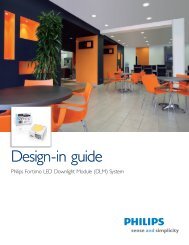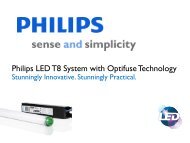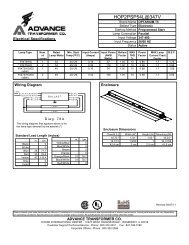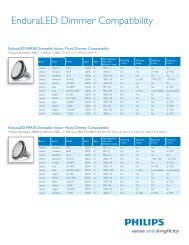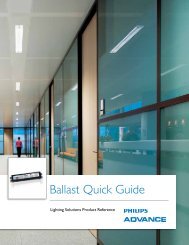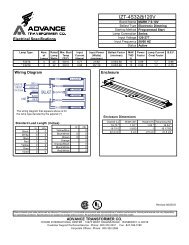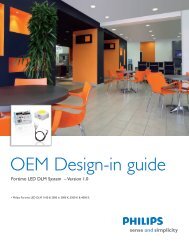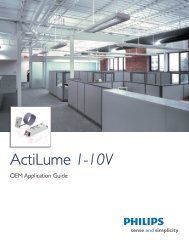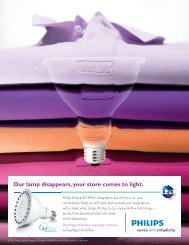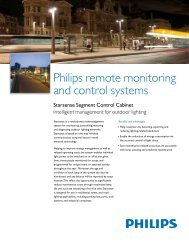Design-in guide - Philips Lighting
Design-in guide - Philips Lighting
Design-in guide - Philips Lighting
Create successful ePaper yourself
Turn your PDF publications into a flip-book with our unique Google optimized e-Paper software.
LEDs power<strong>in</strong>g Fortimo LED Twistable<br />
Downlight Module Gen 2<br />
The development of Light Emitt<strong>in</strong>g Diodes (LEDs) is progress<strong>in</strong>g at such a pace that they<br />
are rapidly ga<strong>in</strong><strong>in</strong>g a majority of use for light<strong>in</strong>g applications. To most people, the term<br />
LED still only means the small <strong>in</strong>dicator lights that show whether the TV set is switched<br />
on. These t<strong>in</strong>y light sources barely emit enough light to make themselves visible. In the<br />
Fortimo LED Twistable Downlight Module Gen 2 system, multi-die white LEDs are used.<br />
This package enables high efficiency, high lumens, and m<strong>in</strong>imum CRI of 80. 3<br />
What is LED?<br />
LEDs are solid-state devices, built up from crystall<strong>in</strong>e layers of semiconductor material.<br />
The light generation process makes use of the special electronic properties of crystall<strong>in</strong>e<br />
semiconductors <strong>in</strong> a process called <strong>in</strong>jection lum<strong>in</strong>escence.<br />
In brief, this means the <strong>in</strong>jection of charged particles by an electric field from one<br />
semiconductor layer <strong>in</strong>to another, where they are able to relax to a lower- energy state<br />
by emitt<strong>in</strong>g visible light. LEDs produce narrow light spectra. The bandwidth rema<strong>in</strong>s<br />
limited to a few tens of nanometers, and is therefore perceived by the human eye as a<br />
s<strong>in</strong>gle, deeply saturated color. LEDs are now available <strong>in</strong> all wavelengths of the visible<br />
spectrum; yellow is the only region <strong>in</strong> which no high-power LED is currently available.<br />
White light can be produced by comb<strong>in</strong><strong>in</strong>g LEDs of different colors (for <strong>in</strong>stance red,<br />
green and blue), or by apply<strong>in</strong>g phosphor coat<strong>in</strong>gs on blue or ultraviolet LEDs. Like many<br />
other lamps, LEDs cannot be connected directly to the ma<strong>in</strong>s. The LEDs have to be<br />
operated at a stabilized low voltage, which is provided by driver electronics.<br />
However, LEDs do not need ignition and can be switched on/off with<strong>in</strong> milliseconds.<br />
LEDs do not generate nearly as much heat as many other lamps, but that does not mean<br />
that thermal design is not important. LEDs do produce heat when they operate, and are<br />
themselves relatively sensitive to temperature. Thermal considerations are therefore<br />
very important aspects of lum<strong>in</strong>aire design that <strong>in</strong>corporates LEDs.<br />
6 <strong>Design</strong> In Guide <strong>Philips</strong> Fortimo LED Twistable Downlight Module Gen 2



